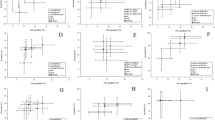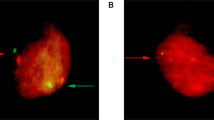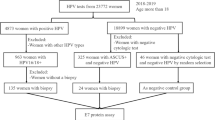Abstract
Objectives
Cervical cancer is the most common malignant tumors in women leading to serious morbidity and mortality worldwide, especially among developing countries. A main cause of the disease is the high-risk human papillomavirus (HR-HPV) infection. HSIL usually progress to cervical cancer, and low-grade lesions, including LSIL and ASCUS, mostly turn to normal or benign lesions, but there are still a small number of patients who will progress to HSIL. Up to now there is no efficient biomarker clinically available to predict people with high risk to progress into HSIL. This study was conducted to evaluate the value of human papillomavirus (HPV) DNA, p16INK4a protein, and HPV L1 capsid protein in predicting HSIL and minimizing unnecessary colposcopy treatments.
Methods
1222 patients with HR-HPV infection or with abnormal Thinprep cytologic test (TCT) were chosen to conduct colposcopy in the cervical out-patient clinic of Shanghai First Maternity and Infant Hospital affiliated to Shanghai Tongji University from June 2014 to January 2017. TCT, cervical biopsy, HPV DNA and HPVL1 were performed on all patients. 110 patients were selected to detect p16INK4a protein. Hybrid capture 2 (HC-2) was used to detect HPV DNA, and their subgroups using gene typing system. Immunohistochemical technology was used to detect HPV L1 and p16.
Results
HPV DNA was positive in 1097 cases, with the positive rate of 89.7% (1097/1222). In particular, the positive expression rates of HPV DNA were 82.3, 95.7, 96.6 and 100% in Normal/CC, LSIL, HSIL and cervical cancer groups, respectively (p < 0.001). HPV L1 was negative in 781 cases with HR-HPV infection, and the overall negative rate is 71.1%. In patients with Normal/CC, LSIL and HSIL, the negative expression rates of HPV L1 were 91.3, 40 and 81.2%, respectively (p value < 0.001). In the 110 patients, HPV L1 was negative in 98.1% (53/54) of Normal/CC, 42.9% (12/28) of LSIL and 85.1% (23/27) of HSIL (p value = 0.0043). P16-positive rates in patients with Normal/CC, LSIL and HSIL were 33.3% (18/54), 75% (21/28) and 96.2% (26/27), respectively (p value < 0.001). 18 out of 28 cases express low positive (+) in LSIL, 25 out of 27 cases express strong positive (3+) in HSIL. Patients with L1(−) p16(+) including 18.5% (10/54) of normal/cervicitis, 60.7% (17/28) of LSIL and 85.1% (23/27) of HSIL (p value < 0.005). Furthermore, patients with L1(−) p16(1+) included 37% (10/27) of normal/cervicitis 59.3% (16/27) of LSIL and 3.7% (1/27) of HSIL; patients with L1(−) p16(2+) consisted of 0% of normal/cervicitis/LSIL and 100% (1/1) of HSIL; patients with L1(−) p16(3+) were composed of 0% of normal/cervicitis, 4.5% (1/22) of LSIL and 95.5% (21/22) of HSIL (p value < 0.005) (Table 6).
Conclusion
With the increase in the degree of the cervical lesions, the expression of HPV DNA and p16 is up-regulated while HPV L1 protein is down-regulated. HPV DNA, HPV L1 and p16 are useful markers for the prediction of HSIL. Combined detection of these three markers has important potential to predicting HSIL and minimizing unnecessary colposcope examination.




Similar content being viewed by others
Abbreviations
- CIN:
-
Cervical intraepithelial neoplasia
- CC:
-
Chronic cervicitis
- LSIL:
-
Low-grade squamous intraepithelial lesion
- HSIL:
-
High-grade squamous intraepithelial lesion
- SCC:
-
Squamous cell carcinoma
- HPV:
-
Human papilloma virus
- IHC:
-
Immunohistochemistry
References
Karabulut A, Alan T, Ali Ekiz M, Iritas A, Kesen Z, Yahsi S (2010) Evaluation of cervical screening results in a population at normal risk. Int J Gynaecol Obstet 110:40–42. https://doi.org/10.1016/j.ijgo.2010.02.011
Munoz N, Bosch FX, de Sanjose S, Herrero R, Castellsague X, Shah KV, Snijders PJ, Meijer CJ, International Agency for Research on Cancer Multicenter Cervical Cancer Study Group (2003) Epidemiologic classification of human papillomavirus types associated with cervical cancer. N Engl J Med 348:518–527
Izadi-Mood N, Sarmadi S et al (2014) Immunohistochemical expression of p16 and HPV L1 capsid proteins as predictive markers in cervical lesions. Arch Gynecol Obstet 289:1287–1292
Franco EL, Rohan TE, Villa LL (1999) Epidemiologic evidence and human papillomavirus infection as a necessary cause of cervical cancer. J Natl Cancer Inst 91:506–511
Meuer CJ, Helmerhorst TJ, Rosendaal L, Van Der Lin-Den JC, Voorhorst FJ, Walboomers JM (1998) HPV typing and testing in gynaecological pathology: has the time come? Histopathology 133:83–86
Yoshida T, Sano T, Kanuma T, Owada N, Sakurai S, Fukuda T, Nakajima T (2008) Immunochemical analysis of HPV L1 capsid protein and p16 protein in liquid-based cytology samples from uterine cervical lesions. Cancer 114:83–88. https://doi.org/10.1002/cncr.23366
Walboomers JM, Jacobs MV, Manos MM et al (1999) Human papillomavirus is a necessary cause of invasive cervical cancer worldwide. J Pathol 189:9–12
Steben M, Duarte-Franco E (2007) Human papillomavirus infection: epidemiology and pathophysiology. Gynecol Oncol 107:S2–S5
Griesser H, Sander H, Hilfrich R, Moser B, Schenck U (2004) Correlation of immunochemical detection of HPV L1 capsid protein in pap smears with regression of high-risk HPV positive mild/moderate dysplasia. Anal Quant Cytol Histol 26:241–245
Ungureanu C, Socolov D, Anton G, Mihailovici MS, Teleman S (2010) Immunocytochemical expression of p16INK4a and HPV L1 capsid proteins as predictive markers of the cervical lesions progression risk. Rom J Morphol Embryol 51:497–503
Safaeian M, Solomon D, Castle PE (2007) Cervical cancer prevention—cervical screening: science in evolution. Obstet Gynecol Clin North Am 34:739–760
Zhang Q, Kuhn L, Denny LA, De Souza M, Taylor S, Wright TC Jr (2007) Impact of utilizing p16INK4A immunohistochemistry on estimated performance of three cervical cancer screening tests. Int J Cancer 120:351–356
Melsheimer P, Kaul S, Dobeck S, Bastert G (2003) Immunocy-tochemical detection of HPV high-risk type L1 capsid proteins in LSIL and HSIL as compared with detection of HPV L1 DNA. Acta Cytol 47:124–128
Choi YS, Kang WD, Kim SM, Choi YD, Nam JH, Park CS, Choi HS (2010) Human papillomavirus L1 capsid protein and human papillomavirus type 16 as prognostic markers in cervical intra-epithelial neoplasia. Int J Gynecol Cancer 20:288–293. https://doi.org/10.1111/IGC.0b013e3181cd184c
Von Knebel Doeberitz M (2002) New markers for cervical dysplasia to visualise the genomic chaos created by aberrant onco-genic papillomavirus infections. Eur J Cancer 38:2229–2242
Galgano MT, Castle PE, Atkins KA, Brix WK, Nassau SR, Stoler MH (2010) Using biomarkers as objective standards in the diagnosis of cervical biopsies. Am J Surg Pathol 34:1077–1087. https://doi.org/10.1097/PAS.0b013e3181e8b2c4
Lee H, Lee KJ, Jung CK, Hong JH, Lee YS, Choi YJ, Lee KY, Park G (2008) Expression of HPV L1 capsid protein in cervical specimens with HPV infection. Diagn Cytopathol 36:864–867. https://doi.org/10.1002/dc.20922
Negri G, Bellisano G, Zannoni GF, Rivasi F, Kasal A, Vittadello F, Antoniazzi S, Faa G, Ambu R, Egarter-Vigl E (2008) p16 ink4a and HPV L1 immunohistochemistry is helpful for estimating the behavior of low-grade dysplastic lesions of the cervix uteri. Am J Surg Pathol 32:1715–1720. https://doi.org/10.1097/PAS.0b013e3181709fbf
Zheng L, Wu Y, Wang Y (2016) Clinical significance of HPV DNA and HPV L1 protein detection in cervical exfoliated cells. China Med Heral 13(5):107–110
Kim JW, Hong JW, Jang HS, Lee SY, Jang SY, Lee DW, Kim SW, Kim JH, Kim YT, Kim S, Kim JW (2008) Expression of the p16 and Ki-67 in relation to the grade of cervical intraepithelial neoplasia and high-risk human papillomavirus infection. J Gynecol Oncol 19:162–168. https://doi.org/10.3802/jgo.2008.19.3.16228
Klaes R, Friedrich T, Spitkovsky D, Ridder R, Rudy W, Petry U, Dallenbach-Hellweg G, Schmidt D, von Knebel Doeberitz M (2001) Overexpression of p16(INK4A) as a specific marker for dysplastic and neoplastic epithelial cells of the cervix uteri. Int J Cancer 92:276–284
Cheah PL, Koh CC, Nazarina AR, Teoh KH, Looi LM (2016) Correlation of p16INK4a immunoexpression and human papillomavirus (HPV) detected by in situ hybridization in cervical squamous neoplasia. Malays J Pathol 38(1):33–38
Huang MZ, Li HB, Nie XM et al (2010) An analysis on the combination expression of HPV L1 capsid protein and p16INK4a in cervical lesions. Diagn Cytopathol 38:573–578
International Agency for Research on Cancer (2005) Cervix cancer screening. IARC handbook of cancer prevention. IARC, Lyon
Arbyn M, Antilla A, Jordan J, Ronco G, Schenck U, Segnan N et al (2008) European guidelines for quality assurance in cervical cancer screening, 2nd edn. Office for Official Publications of the European Communities, Luxembourg
Klaes R, Benner A, Friedrich T, Ridder R, Herrington S, Jenkins D, Kurman RJ, Schmidt D, Stoler M, von Knebel Doeberitz M (2002) p16INK4a immunohistochemistry improves interobserver agreement in the diagnosis of cervical intraepithelial neoplasia. Am J Surg Pathol 26:1389–1399
Stoler MH, Schiffman M (2001) Interobserver reproducibility of cervical cytologic and histologic interpretations: realistic estimates from the ASCUS-LSIL triage study. JAMA 285:1500–1505
Cuzick J (2010) Long-term cervical cancer prevention strategies across the globe. Gynecol Oncol 117:S4–S11
Ayatollahi H, Homaei-Shandiz F, Kooshyar MM, Tabatabaee-Yazdi SA, Mehrjerdian M, Jafarian AH et al (2014) Human papilloma virus 16/18 genotypes in patients with squamous cell carcinoma of cervix in northeast Iran. Niger Med J 55:495–498
Lagos M, Van De Wyngard V, Poggi H, Cook P, Viviani P, Barriga MI et al (2015) HPV16/18 genotyping for the triage of HPV positive women in primary cervical cancer screening in Chile. Infect Agent Cancer 10:43
Vidal AC, Smith JS, Valea F, Bentley R, Gradison M, Yarnall KS et al (2014) HPV genotypes and cervical intraepithelial neoplasia in a multiethnic cohort in the southeastern USA. Cancer Causes Control 25:1055–1062
Izadi-Mood N, Sarmadi S, Eftekhar Z et al (2014) Immunohistochemical expression of p16 and HPV L1 capsid proteins as predictive markers in cervical lesions. Arch Gynecol Obstet 289:1287–1292
Xiao W, Bian M, Ma L et al (2010) Immunochemical analysis of human papillomavirus L1 capsid protein in liquid-based cytology samples from cervical lesions. Acta Cytol 54(5):661–667
Negri G, Bellisano G, Zannoni GF, Rivasi F, Kasal A, Vittadello F, Antoniazzi S, Faa G, Ambu R, Egarter-Vigl E (2008) p16ink4a and HPV L1 immunohistochemistry is helpful for esti-mating the behavior of low-grade dysplastic lesions of the cervix uteri. Am J Surg Pathol 32:1715–1720. https://doi.org/10.1097/PAS.0b013e3181709fbf
Griesser H, Sander H, Hilfrich R et al (2004) Correlation of immunochemical detection of HPV L1 capsid protein in pap smears with regression of high-risk HPV positive mild/moderate dysplasia. Anal Quant Cytol Histol 26(5):241–245
Alshenawy HA (2014) Evaluation of p16, human papillomavirus capsid protein L1 and Ki-67 in cervical intraepithelial lesions: potential utility in diagnosis and prognosis. Pathol Res Pract 210:916–921
Zhang Q, Kuhn L, Denny LA et al (2007) Impact of utilizing p16INK4A immunohistochemistry on estimated performance of three cervical cancer screening tests. Int J Cancer 120:351–356
Roelens J, Reuschenbach M, von Knebel Doeberitz M et al (2012) p16INK4a immunocytochemistry versus human papillomavirus testing for triage of women with minor cytologic abnormalities: a systematic review and meta-analysis. Cancer Cytopathol 120:294–307
Liao GD, John W et al (2014) p16INK4A immunohistochemical staining and predictive value for progression of cervical intraepithelial neoplasia grade 1: a prospective study in China. Int J Cancer 134:1715–1724
Acknowledgements
This work was supported by Shanghai Science and Technology Committee Foundation (Grant no. 15411967700, 16411950200), National Natural Science Foundation of China (Grant no. 81771529), and Shanghai Natural Science Foundation (Grant no. 15ZR1433300).
Author information
Authors and Affiliations
Corresponding authors
Ethics declarations
Conflict of interest
The authors declare no potential conflicts of interest.
Rights and permissions
About this article
Cite this article
Hu, H., Zhao, J., Yu, W. et al. Human papillomavirus DNA, HPV L1 capsid protein and p16INK4a protein as markers to predict cervical lesion progression. Arch Gynecol Obstet 299, 141–149 (2019). https://doi.org/10.1007/s00404-018-4931-1
Received:
Accepted:
Published:
Issue Date:
DOI: https://doi.org/10.1007/s00404-018-4931-1




